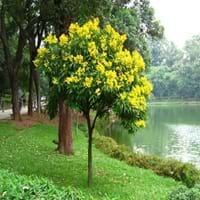Life Span
Perennial
Perennial
Type
Flowering Plants, Fruits, Trees
Tree
Origin
Central America, Europe, North America
Southwestern United States, Mexico, Central America, South America, Argentina, Brazil
Types
Not Available
Yellow elder, Ginger thomas
Habitat
Hedge, Scrubs, Woods
Subtropical climates, Tropical regions
USDA Hardiness Zone
4-8
8-15
AHS Heat Zone
Not Available
12-10
Sunset Zone
Not Available
H1, H2, 10, 12, 13, 21, 22, 23, 24
Habit
Not Available
Arching/Fountain-shaped
Flower Color
White
Lemon yellow
Flower Color Modifier
Not Available
Bicolor
Leaf Color in Spring
Dark Green
Green, Dark Green
Leaf Color in Summer
Green
Dark Green
Leaf Color in Fall
Brown, Green, Light Yellow
Dark Green
Leaf Color in Winter
Not Available
Dark Green
Leaf Shape
Oblong
Lance shaped
Plant Season
Summer
Spring, Summer, Fall
Sunlight
Full Sun, Partial shade
Full Sun, Partial Sun
Type of Soil
Loamy
Loam, Sand
The pH of Soil
Neutral
Acidic, Neutral, Alkaline
Soil Drainage
Well drained
Well drained
Bloom Time
Fall, Summer
Spring, Late Spring, Early Summer, Summer, Late Summer, Early Fall, Fall, Late Fall, Early Winter
Tolerances
Drought
Cold climate, Drought
Where to Plant?
Ground
Ground
How to Plant?
Grafting, Seedlings, Transplanting
Seedlings, Stem Planting
Plant Maintenance
Medium
Low
Watering Requirements
Medium
Average Water Needs, Do Not over Water, Never Over-water, Requires regular watering
In Summer
Lots of watering
Ample Water
In Spring
Moderate
Average Water
In Winter
Average Water
Average Water
Soil pH
Neutral
Acidic, Neutral, Alkaline
Soil Type
Loamy
Loam, Sand
Soil Drainage Capacity
Well drained
Well drained
Sun Exposure
Full Sun, Partial shade
Full Sun, Partial Sun
Pruning
Prune when plant is dormant, Remove dead or diseased plant parts
Prune in winter, Remove damaged leaves, Remove dead branches, Remove dead leaves, Remove dead or diseased plant parts
Fertilizers
All-Purpose Liquid Fertilizer
All-Purpose Liquid Fertilizer, Nitrogen, Phosphorous, Potassium
Pests and Diseases
Aphids, Curculio occidentis, Japanese Beetles, Leaf Rollers, Leafminer, Mites, Red blotch, sawflies, Scale, Stink bugs
Red blotch, Sawfly Larvae
Plant Tolerance
Drought
Cold climate, Drought
Flower Petal Number
Single
Single
Foliage Texture
Medium
Medium
Foliage Sheen
Matte
Matte
Attracts
Not Available
Birds, Hummingbirds, Butterflies
Allergy
Digestive Problems, Respiratory problems
Asthma
Aesthetic Uses
Showy Purposes
Beautification, Landscape Designing, Showy Purposes
Beauty Benefits
Beautiful Skin
No Beauty Benefits
Environmental Uses
Food for birds
Air purification, Food for insects
Medicinal Uses
Anthelmintic, Antibacterial, Astringent, Hypnotic, Laxative, Refrigerant
Diuretic
Part of Plant Used
Fruits
Not Available
Other Uses
Edible syrup, Jam, Jelly, Used As Food
Decoration Purposes, Showy Purposes, Used as Ornamental plant
Used As Indoor Plant
No
No
Used As Outdoor Plant
Yes
Yes
Garden Design
Not Available
Container, Feature Plant, Foundation, Hedges, Mixed Border, Tropical
Botanical Name
Malus sylvestris
TECOMA stans
Common Name
European crab apple
Esperanza , Yellow Trumpetbush
In Hindi
european crab apple
Esperanza
In German
Der Holzapfel, Europäischer Wildapfel
Esperanza
In French
Le Boquettier, le Pommier sauvage ou Pommier des bois
Esperanza
In Spanish
Malus sylvestris, el Manzano silvestre, manzano silvestre europeo
Esperanza
In Greek
Ευρωπαϊκή μήλο καβουριών
Esperanza
In Portuguese
Malus sylvestris
Esperanza
In Polish
Jabłoń dzika
Esperanza
In Latin
european crab apple
Esperanza
Phylum
Magnoliophyta
Tracheophyta
Class
Magnoliopsida
Magnoliopsida
Family
Rosaceae
Bignoniaceae
Clade
Angiosperms, Eudicots, Rosids
Angiosperms, Asterids, Eudicots
Tribe
Not Available
Tecomeae
Subfamily
Not Available
Not Available
Number of Species
Not Available
Season and Care of European Crab Apple and Esperanza
Season and care of European Crab Apple and Esperanza is important to know. While considering everything about European Crab Apple and Esperanza Care, growing season is an essential factor. European Crab Apple season is Summer and Esperanza season is Summer. The type of soil for European Crab Apple is Loamy and for Esperanza is Loam, Sand while the PH of soil for European Crab Apple is Neutral and for Esperanza is Acidic, Neutral, Alkaline.
European Crab Apple and Esperanza Physical Information
European Crab Apple and Esperanza physical information is very important for comparison. European Crab Apple height is 25.00 cm and width 20.00 cm whereas Esperanza height is 300.00 cm and width 120.00 cm. The color specification of European Crab Apple and Esperanza are as follows:
European Crab Apple flower color: White
European Crab Apple leaf color: Dark Green
Esperanza flower color: Lemon yellow
- Esperanza leaf color: Green and Dark Green
Care of European Crab Apple and Esperanza
Care of European Crab Apple and Esperanza include pruning, fertilizers, watering etc. European Crab Apple pruning is done Prune when plant is dormant and Remove dead or diseased plant parts and Esperanza pruning is done Prune in winter, Remove damaged leaves, Remove dead branches, Remove dead leaves and Remove dead or diseased plant parts. In summer European Crab Apple needs Lots of watering and in winter, it needs Average Water. Whereas, in summer Esperanza needs Ample Water and in winter, it needs Average Water.





